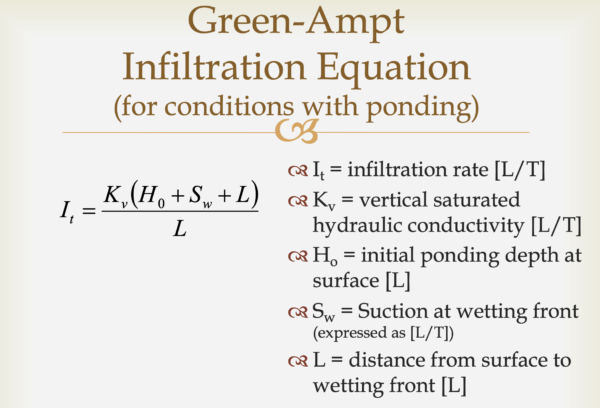This post is part of a series in which I provide the details of each unit I taught post-transitioning to online in Spring 2020 in the Watershed Hydrology class at Kent State University. For more context about the course and my perspective on it, please read the introductory post. [I’ve added some bracketed notes about things I’d change up for a future online offering.]
[For 2020, this was the last section of my watershed hydrology course. (Sometimes, I have time for a specific unit on tracers and/or water quality). This is a little bit of a weird unit in that I included some content on analyses you can do with streamflow data before shifting to a focus on floods. This had more to do with evening out content vs. time than any innate splitting of streamflow analysis topics and/or grouping with floods. I do not expect students to do any of the analyses I talk about here, except some basic flood frequency analysis, but I want them to know the many ways that streamflow data are used and that they could explore in advanced class, in graduate research, or in their careers.]
In this unit, we explore:
- more hydrological analyses you can do with streamflow data
- basic flood definitions
- flood frequency analysis (focus of associated problem set)
- how we measure floods when there is no USGS gage (or it is wiped out by a flood)
- what causes floods, and
- how we manage floods
Learning Objectives
- List several analyses that can be done with streamflow discharge data, other than hydrographs and flow duration curves
- Discuss how graphical- and tracer-based hydrograph separations work and the insights gained from each
- Identify some of the data inputs required for watershed hydrological modeling, river forecasting, and hydraulic modeling
- Describe the criteria used to distinguish between National Weather Service flood levels
- Demonstrate how to conduct a flood frequency analysis and interpret the results of one
- Identify why discussing floods in terms of probability and not recurrence interval is considered the best practice
- Give examples of situations that require caution when calculating flood probabilities
- Describe two methods that can be used to estimate flood flows when there is no stream gage
- Describe the common ways that meteorological floods are generated and the spatial and time scales associated with each
- Discuss the role of topography and human land use in modulating flood dynamics
- Identify how climate change may be altering flood frequency and severity
- Compare flood control reservoirs, levees, and natural flood management as approaches for managing floods
More hydrological analyses you can do with streamflow data
In this video, I talk about some of the ways that stream discharge data can be used to gain insight into processes occurring within a watershed. I talk about graphical and tracer based hydrograph separation, recession analysis, and hydrological modeling for what-if scenarios and river forecasting. You won’t know the details of how to do the analyses after watching the video, but you’ll know what sorts of possibilities exist.
Want to follow along with the slides? They are here (PDF), but I do recommend the video to get the context of the text and images on the slides.
More about river forecasting
The National Weather Service combines weather forecasts, watershed models, and stream gage data to make predictions of future flows at many locations around the US. This video takes you inside a river forecast center to learn more about how they operate.
What is the definition of a flood?
To kick off our course content on floods, start with this video. If you just want the slides, they are here (PDF).
How to do a basic flood frequency analysis
This was the need-to-know content for the last problem set for my students. If you just want the slides, they are here (PDF).
Why you can get a 500-year flood 2 years in a row
This is a blog post I wrote a while ago about flood frequency. It reinforces some of the things I talk about in my video lecture.
Some important cautionary notes about flood frequency analysis
Now that you know how to do a flood frequency analysis, you shouldn’t just blindly do one with any dataset you can find. Here I talk about some cautions.
If you just want the slides, they are here (PDF). Here’s the Milly et al. (2008) piece on stationary and whether it is dead.
Case study: Flood wave propagation in Pakistan
In this short blog post, devastating flooding moving downstream in Pakistan’s Indus River watershed is an example of the timescales and effects of flood wave propagation. Flood wave propagation comes up in my cautionary notes video above.
Case study: Flooding on the Red River of the North
The Red River of the North and its annual ice-jam floods comes up in my cautionary notes on flood frequency analysis video. Here’s a blog post I wrote if you want to read a little bit more about this interesting (and very flat) area.
How do we quantify floods when there is no streamgage?
At the end of my video on cautionary notes about flood frequency analysis, I mentioned some ways we can still estimate flood flows even when there’s no stream gage. The two videos below give you an overview of these important methods.
Hydraulic Models
This video discusses how hydraulic models are used for floodplain mapping and other engineering applications. Hydraulic models, which focus on the mechanics of flow within a channel(or floodplain!) are different than the hydrologic or watershed models I discussed in the “more streamflow analyses” video. Hydrologic models, that focus on the water balance in all parts of a watershed, can be used to provide the input data for a hydraulic model or even be coupled directly into the same computer program.
How to make an indirect measurement of a flood, using Manning’s Equation
In this video, a USGS hydrologist explains the basic theory and measurements needed to make an indirect measurement of flood discharge using the Manning’s equation. Please note that the constant of 1.486 only applies if you use English units. If you use metric units, the constant is 1. Because of course it is.
What causes floods?
A flood comes from too much water, but what causes the too much water? I’ve written a blog post giving overviews of the most common meteorological flood generation mechanisms, from isolated thunderstorms to hurricanes and monsoons.
Note that there are a whole other set of flood generating mechanisms including dam breaks, glacial outbursts, landslide dams, and volcanoes that I don’t even cover here. You’ll just have to stalk my blog after the semester is over to see if I make good on my promise to write about them. Or ask me – I LOVE to talk about this sort of stuff.
Once you’ve read the blog post linked above, you may want to read more about some of the case studies I mention in it. I’ve linked many of them below for your combined reading ease. Note that these are all optional, but you may find them helpful to gain additional details on the concepts in the blog post above.
- Case Study: Ellicott City, Maryland. Convective thunderstorm + urbanization + climate change (blog post by me).
- Case Study: Colorado floods in 2013. Mesoscale convective system that stalled out. (journal article, pretty readable, open access)
- Case Study: Irene in Vermont and Lee in the Susquehanna. Tropical Cyclones meet Steep Topography (blog post, by me)
- Case Study: Hurricane Harvey. Part 1: Climate Change. Part 2: Urbanization. (blog posts, by me)
- Case Study: Atmospheric Rivers and flooding on Mt. Hood. 2011 events. 2006 events. (blog posts, by me)
- Case Study: Monsoon flooding and climate change in India in 2019. (feature news article)
- Case Study: Monsoon flooding in Pakistan in 2010. As it happened. Climate change tie-in.
Some of the largest floods in geologic history
Optional reading if you want to know about one of the most spectacular floods ever. It will blow your mind.
How do we manage floods?
After all this talk of flooding, you might be asking, what can we do? This last section of the course is designed to help answer that and leave you with a realistic, but maybe hopeful, sense of how hydrologists, engineers, and environmental scientists can help manage floods by working with a watershed’s hydrology and landscape.
This video provides a good introductory overview of several approaches to flood management.
Levees and the illusion of flood control
In this blog post, I use my hometown to discuss some of the risks of a heavy reliance on levees to manage flood risks.
How levees can make things worse
How do flood control dams and spillways work?
This video presents an engineering perspective on how flood control dams operate, how spillways work and how they are integral to the design and operation of dams.
One of the important things this video points out is the risk of dam or spillway failure. When such a failure seems like a real possibility, dam operators will do everything within their power to prevent the worst from happening, even if that guarantees that downstream flooding will get worse. This was part of the drama that happened in Houston during Hurricane Harvey.
[Note: I really wish I’d been able to accompany this content on the engineering of dams with some examples of how they change hydrographs in multiple different ways, but, frankly, I ran out of time to prepare that material and couldn’t find an already produced video or written piece that was appropriate. I’d love to know about one, if you’ve got one.]
Natural flood management: a (re)emerging trend
There are lots of opportunities for geologists and environmental professionals to become involved in natural flood management and many other exciting aspects of hydrology. Your training in watershed hydrology could be a launching point for a career managing water resources, protecting people, and improving the environment. But whatever you choose to do after this course is over, I hope that some appreciation for the way water moves through landscapes sticks with you. Thank you for being wonderful students this semester and know that I will be thinking of you for a long time after this semester is over.
Assessment
- 10 question multiple choice quiz, drawn from a bank of more than 10 questions. Students could take the quiz twice.
- Problem set focused on flood frequency and qualitatively assessing uncertainties associated with estimating floods. This year, the problem set had the added bonus of a “record-breaking flood” on the stream we use in the problem set occuring after the end of 2019 water year. That allowed students to construct the flood frequency curve, then look up the 2020 flood discharge, calculate an estimated frequency for it, and then discuss how the assignment would change for next year’s class when that data point was included.
- Questions on the final exam, including interpretation of a flood frequency graph.
Please respect my work
This work (my videos and blog posts) are licensed under an Attribution-NonCommercial-NoDerivs 3.0 Unported (CC BY-NC-ND 3.0). That means that you need to give appropriate credit if you use or modify anything I’ve posted here. It also means that you can’t use the material for commercial purposes. If you want to use other resources I’ve listed above, please respect the rights of the originators. If you want to use my sequencing of topics and resources in your class, by all means, go ahead.





Nice plan for content warnings on Mastodon and the Fediverse. Now you need a Mastodon/Fediverse button on this blog.